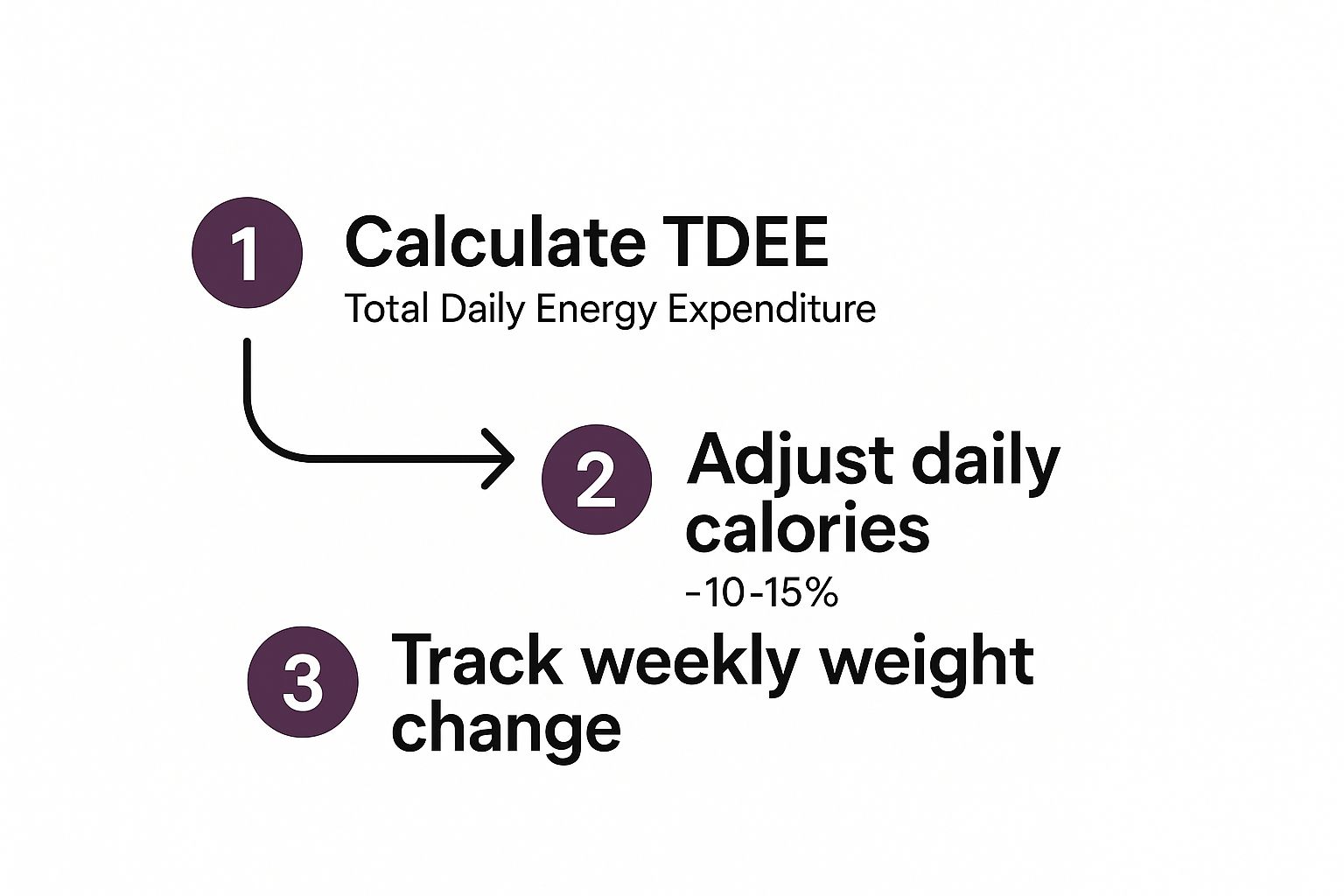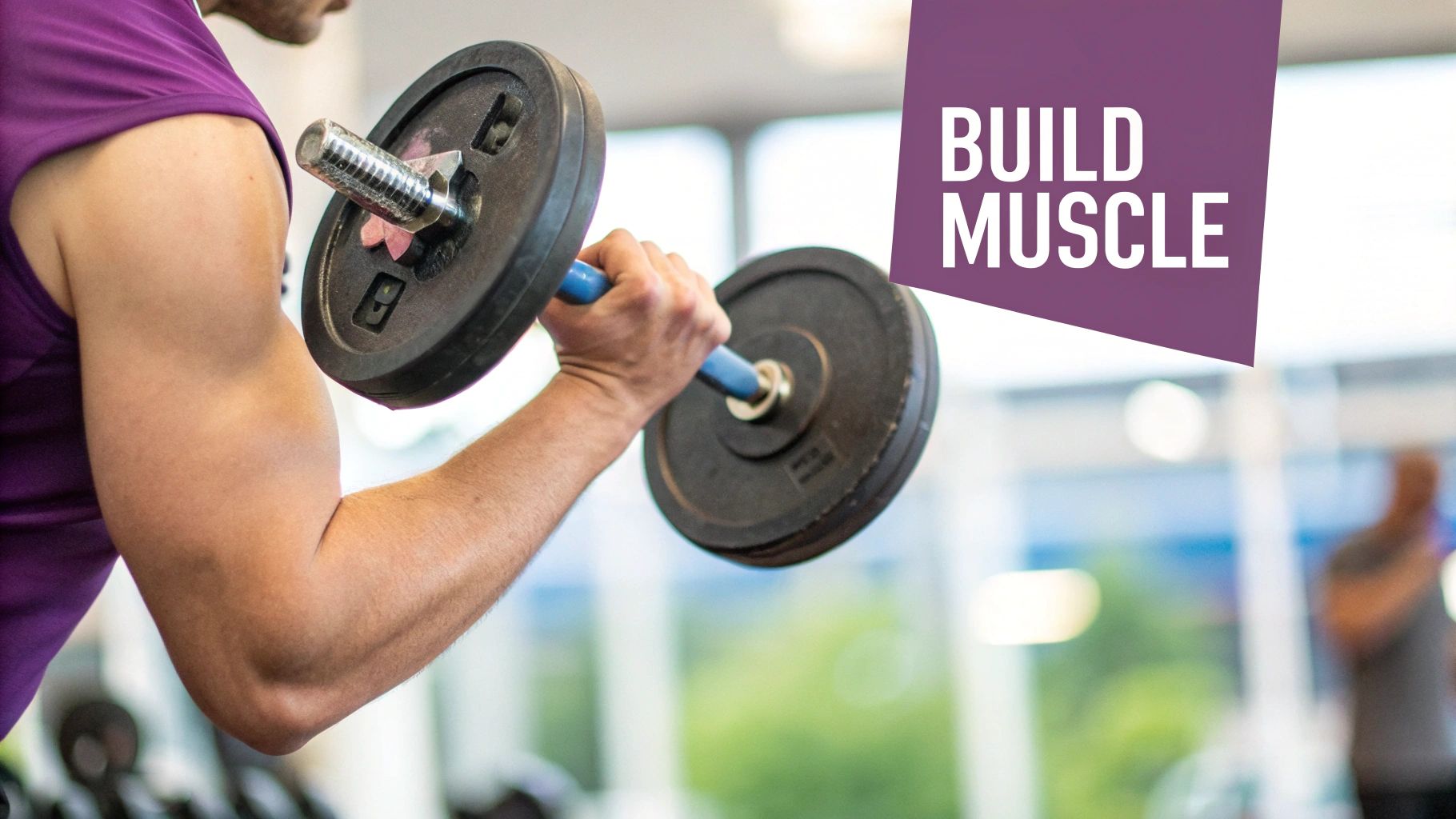
How to Overcome a Weight Loss Plateau: Your Guide to Getting Unstuck
You’re doing everything right, but the scale won't budge. Sound familiar? It’s a frustratingly common part of almost every weight loss journey.
Hitting a plateau isn't a sign that you've failed. It’s a sign your body has adapted to your new habits. The trick is to make a few strategic shifts.
Why Your Weight Loss Has Stalled
A weight loss plateau happens when steady weight loss suddenly stops. For weeks on end, nothing changes. It’s not in your head—there’s a real biological reason for it. As you lose weight, your body changes.
One of the biggest culprits is your metabolism. A smaller body doesn't need as many calories. The diet that helped you drop the first 10 pounds might now just be enough to maintain your current weight. Your body has become more efficient.
The Science Behind the Stall
This metabolic slowdown is real. For every kilogram (about 2.2 pounds) of weight you lose, your daily calorie burn can drop by 20-30 kcal. At the same time, your appetite often ramps up by about 100 kcal per day. You burn less and feel hungrier. It’s a tough combination that can halt your progress.
The plateau isn't a dead end; it's a checkpoint. It's your body's way of telling you that it has adapted, and it's time for a new strategy to keep moving forward.
More Than Just Weight
It's also really important to look beyond the scale. If you’re exercising, you could be making amazing progress that the scale won't show. You might be losing fat while building lean muscle.
Muscle is much denser than fat, so the scale can stay the same even as you get leaner and stronger. This is why understanding what is body composition is so critical.
Track more than just your weight. Start paying attention to:
- Body fat percentage
- How your favorite jeans fit
- Your energy levels during workouts
- Progress photos
These metrics paint a more accurate picture of what's happening. Once you understand why you’re stuck, you can get strategic.
Here's a quick checklist to get started.
Your Plateau-Breaker Action Plan
| Action Item | Why It Works | Your First Step |
|---|---|---|
| Recalculate Your Calories | Your smaller body needs fewer calories. A quick adjustment can reignite fat loss. | Use an online TDEE calculator with your current weight to find your new maintenance number. |
| Increase Your Protein | Protein keeps you full, boosts metabolism, and helps preserve muscle mass while dieting. | Add a scoop of protein powder to your morning smoothie or have Greek yogurt as a snack. |
| Try a New Workout | Your body adapts to exercise. Changing the intensity, duration, or type of workout creates a new challenge. | If you always jog, try a HIIT class or a strength training session this week. |
| Track Everything for 3 Days | Small bites, sauces, and drinks add up. This "calorie creep" is a common plateau cause. | Use an app like MyFitnessPal and be brutally honest about every single thing you eat and drink. |
| Prioritize Sleep | Poor sleep raises cortisol and ghrelin (the hunger hormone), making fat loss much harder. | Set a bedtime alarm and turn off all screens 30-60 minutes before you want to be asleep. |
Tackling one or two of these can get the needle moving again. Pick what feels manageable and build from there.
Recalculate Your Daily Calorie Needs
When you first started losing weight, you likely calculated a calorie target. But that number isn’t forever. The diet that worked for the first 10 or 15 pounds probably isn't right for your new, leaner body.
As you lose weight, your body adapts. A smaller body needs less energy. The calorie deficit that was working so well might have disappeared.
Why Your Old Numbers Don't Work Anymore
Your original calorie goal was for a heavier version of you. Now that you're lighter, your Basal Metabolic Rate (BMR) has dropped. This also lowers your Total Daily Energy Expenditure (TDEE), the total calories you burn.
Sticking to your old calorie count is a common cause for a plateau. You have to adjust your intake to match who you are now.
A weight loss plateau isn't a failure. It’s a sign of success! Your body has changed, and now it's time for your plan to change with it.
Figuring out your new needs is about making a smart, small adjustment. Use an online TDEE calculator with your current weight, height, age, and activity level. Once you have that new maintenance number, subtract 10-15% (usually 200-500 calories) to create a fresh deficit.
For more details, our guide on what is a calorie deficit is a great resource.
This visual shows the process.

Breaking a stall begins with data. Recalculate your TDEE, tweak your calories, and track your progress.
Focus on Protein to Protect Your Muscle
Recalculating calories is crucial, but what you eat matters just as much. In a deficit, your body can burn muscle for energy. Losing muscle slows your metabolism, making the plateau worse.
Protein protects that hard-earned muscle while you lose fat. It also has a high thermic effect of food (TEF), meaning your body burns more calories digesting it. Plus, it keeps you feeling full, helping you stick to your new calorie goal.
Simple Ways to Boost Your Protein
You don't need a complete diet makeover. Small, consistent changes make a huge difference.
- Rethink Breakfast: Swap a bagel for eggs, Greek yogurt, or a protein smoothie.
- Snack Smarter: Instead of chips, try a handful of almonds, a cheese stick, or beef jerky.
- Beef Up Your Salads: Add grilled chicken, chickpeas, or hard-boiled eggs to make salads more filling.
Make Portion Control Effortless
Adjusting to new calorie goals can feel overwhelming, especially when eyeballing portions. This is where "calorie creep" sneaks in—a little extra dressing, a larger scoop of rice—and your deficit vanishes.
Using visual cues is a game-changer. Our Portion Control Plate Set removes the guesswork. The plate has sections for protein, carbs, and vegetables, guiding you to build balanced meals without measuring cups. This simple tool helps ensure your hard work pays off.
Shake Up Your Workout Routine
Remember when you first started working out and saw quick results? If that same routine now feels easy, your body has adapted.
Our bodies are smart. They learn to perform the same movements using less energy, which means fewer calories burned. This is a classic sign of a fitness plateau.
The solution? Introduce variety and increase intensity. You need to challenge your body in new ways to reignite your calorie burn.

Embrace High-Intensity Interval Training
One of the most powerful tools for smashing a plateau is High-Intensity Interval Training (HIIT). It's about short bursts of all-out effort followed by brief recovery.
Think 30-second sprints followed by 60 seconds of walking, repeated for just 15-20 minutes.
The magic of HIIT happens after your workout. It creates an "afterburn effect" (EPOC), where your body burns calories at a higher rate for hours. It’s an incredibly efficient way to maximize results.
If you're new to HIIT, the Diet & Exercise YouTube channel has a fantastic 'HIIT for Beginners' video that's perfect for starting at home.
Build Muscle to Burn More Fat
Cardio is great for burning calories, but strength training turns your body into a 24/7 fat-burning machine. Building lean muscle is non-negotiable for overcoming a plateau.
Muscle is metabolically active. The more muscle you have, the more calories your body burns at rest. Strength training prevents the muscle loss that often happens during weight loss, keeping your metabolic engine running.
Think of muscle as your body's personal furnace. The bigger the furnace, the more fuel it burns all day long, making it far easier to stay in a calorie deficit and see the scale move again.
You don't need to be a bodybuilder. Adding resistance training 2-3 times per week makes a significant difference.
The Perfect Tool for Home Workouts
You don't need a gym membership to build strength. A good set of resistance bands is one of the best tools for home workouts. They challenge your muscles and can be adjusted as you get stronger.
Our Adjustable Resistance Bands Set is the perfect way to add that necessary challenge from your living room. They’re portable, simple to use, and open up a huge variety of exercises, from squats to bicep curls. They are exactly what you need to break through that fitness plateau and see progress again.
Make Smart Diet Adjustments
When the scale stops moving, it’s easy to panic. But drastic changes often lead to burnout.
A better approach is to make small, intelligent tweaks. It’s not about eating less; it’s about eating smarter to work with your body’s new reality. The right adjustments can reset hormones, keep you full, and get things moving again.

Consider a Planned Diet Break
Being in a calorie deficit for months is tough. Your metabolism slows down, and hunger hormones get out of whack. A planned “refeed day” or a short diet break can work wonders.
A proper refeed day means intentionally increasing your calories for one day, focusing on carbs. This restocks muscle glycogen and signals to your body that it isn't starving, which can help normalize hormones and nudge your metabolism.
Optimize Your Nutrient Timing
When you eat matters, especially when trying to bust a plateau. Nailing your nutrient timing around workouts can make a huge difference in performance and recovery.
For example, getting protein within an hour or two after strength training is a game-changer for muscle repair. Remember, muscle is your metabolic engine. A protein shake or a meal with lean chicken right after your workout maximizes your efforts.
A common mistake I see is people jumping from one diet to another, thinking the diet itself is the problem. The issue is almost always physiological. Your body has simply adapted. Small, strategic changes to what you're already doing are far more effective than a complete dietary overhaul.
Don't Abandon the Basics
Sometimes a plateau happens because basic habits slip. Before trying anything complex, check in on these two non-negotiables: hydration and fiber.
- Stay Hydrated: Water is critical for burning fat. Even mild dehydration can slow your metabolism. Aim for 8-10 glasses a day to feel fuller and prevent mistaking thirst for hunger.
- Fill Up on Fiber: Foods packed with fiber—like vegetables and fruits—keep you full. Fiber slows digestion, helping you stick to your calorie targets without feeling hungry.
Getting these fundamentals right makes all your other efforts more effective.
Fuel Your Goals with the Right Recipes
Making these shifts can feel complicated, but they don't have to be. If you're looking for delicious meal ideas packed with the protein and fiber you need, our High-Protein Recipe E-book is a fantastic resource. It’s filled with satisfying recipes designed to help you break through plateaus without feeling like you’re on a diet.
Don’t Underestimate Sleep and Stress
If the scale has stopped moving, the culprit might not be your diet or exercise. Often, it's chronic stress and poor sleep secretly sabotaging your efforts.
Sometimes, the best move is to focus on rest and recovery. These factors have a massive impact on the hormones that control your appetite and fat storage.
How Stress Puts the Brakes on Fat Loss
When you’re constantly stressed, your body is flooded with cortisol. Chronically high cortisol is a roadblock for weight loss. It cranks up cravings for high-fat, high-sugar foods.
Worse, it tells your body to hang onto fat, particularly around your midsection. Managing stress is a core strategy for your waistline.
A plateau isn't a failure. Think of it as your body hitting a pause button to recalibrate. The trick is to look beyond the obvious and address the silent saboteurs like stress and sleep.
A few simple stress-management habits can work wonders.
- Take a Five-Minute Breather: Just five minutes of focused breathing can lower cortisol.
- Do Some Light Stretching: Gentle yoga can release tension. Look up a "Yoga for Stress Relief" video on the Diet & Exercise YouTube channel.
- Get Outside: A quick 10-minute walk can do wonders for your mood.
Why Quality Sleep Is Your Secret Weapon
The link between sleep and weight is incredibly strong. When you skimp on sleep, you throw your hunger hormones into chaos.
Ghrelin (the "I'm hungry" hormone) shoots up, while leptin (the "I'm full" hormone) drops. This leaves you feeling ravenous. Research shows sleep-deprived people tend to eat an extra 385 calories the next day.
Dialing in your sleep hygiene might be the most effective thing you can do.
- Lock in Your Schedule: Go to bed and wake up around the same time daily, even on weekends.
- Create Your Cave: Your bedroom should be cool, dark, and quiet.
- Build a Wind-Down Ritual: Put away screens 30-60 minutes before sleep. Read a book or take a warm bath.
Scientists have found that plateaus are usually temporary phases before weight loss resumes. You can discover more insights about these findings to better understand the science.
Connect Your Mood to Your Meals
Have you ever stopped to ask why you’re eating? Is it true hunger, or boredom, stress, or exhaustion? Making that distinction is a game-changer.
That’s why we created our Mindful Eating Journal. It goes beyond logging what you ate. It prompts you to jot down how you’re feeling before, during, and after a meal. This simple practice helps you spot patterns between your emotions and food choices, giving you the power to break cycles keeping you stuck.
Common Questions About Weight Loss Plateaus
Even when you know the science, it's normal to have questions. Getting clear answers is the first step to getting your momentum back.
Let's tackle some common concerns.

Is a Plateau a Sign I'm Doing Something Wrong?
Absolutely not. A weight loss plateau is often a sign of success! It means your body has adapted to your routine.
Your body is an efficient machine. The plan that worked for the first 15 pounds was for your old body. Now that you're lighter, you need less energy. It’s time for your strategy to evolve.
How Long Does a Weight Loss Plateau Last?
It's different for everyone. A true plateau is when weight loss stalls for three to four weeks or longer, despite sticking to your plan.
Anything shorter is probably a normal fluctuation. Your weight can bounce around daily due to water, hormones, and digestion. If a month goes by, it's time to make adjustments.
Should I Just Eat Less to Break a Plateau?
Drastically slashing your intake is one of the worst things you can do. It can slow your metabolism and cause you to lose precious muscle.
Instead of just eating less, eat smarter.
- Pump Up the Protein: Protein preserves muscle and keeps you feeling full.
- Focus on Fiber: Fiber-rich foods add bulk without tons of calories, helping you feel satisfied.
- Stay Hydrated: Drink your water! It’s essential for a healthy metabolism.
A plateau isn't a signal to starve yourself. It's an invitation to refine your approach, focusing on nutrient quality and strategic exercise rather than just deprivation.
Is It Better to Focus on Diet or Exercise?
The most powerful strategy combines both. You can't out-exercise a bad diet, but relying only on calorie restriction leads to muscle loss.
The magic happens when you pair smart dietary tweaks with a fresh workout. If you've only been doing cardio, add 2-3 days of strength training. If you're already lifting, incorporate some HIIT.
For great workout ideas, check out the Diet & Exercise YouTube channel. They have routines for every fitness level.
Will I Ever Start Losing Weight Again?
Yes, one hundred percent! Weight loss is almost never a straight line down. It’s full of peaks, valleys, and plateaus. Consistency is what leads to success.
By making small, intelligent changes to your nutrition, shocking your system with a new workout, and managing sleep and stress, you can absolutely push past this. See this as a chance to learn more about your body and build habits that last.
At Diet & Exercise, we're all about giving you the tools and knowledge to conquer any challenge on your fitness journey. Our apparel and gear are designed to support you every step of the way, from that very first workout to breaking through your latest plateau.
